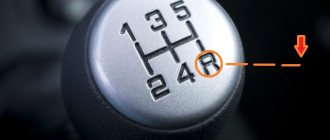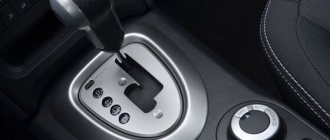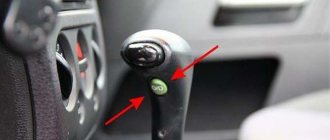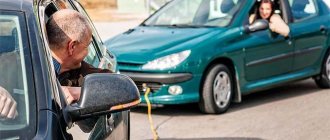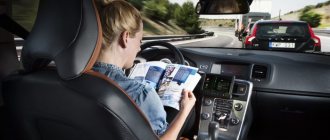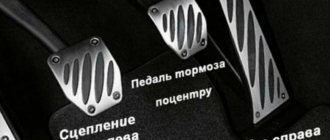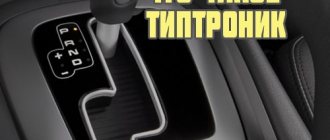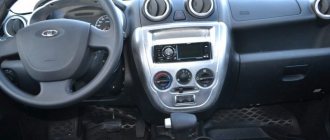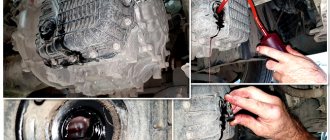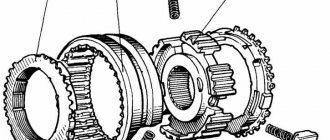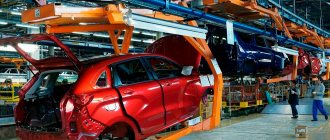How to drive an automatic transmission to avoid breakdowns and extend the life of the unit? You buy a car with an automatic transmission, thinking that life on the road will be a fairy tale, because you just need to press the gas and brake pedals. But then you find out that an automatic transmission is not so simple: in order to drive comfortably for many years, you need to operate the transmission correctly.
Range P (Park) - parking mode.
This mode is selected when the car is parked for a long time. In this position, the controls in the box are disabled, the output shaft is blocked, and as a result, the machine cannot move (the drive wheels are blocked, the blocking is not associated with the parking brake and is located inside the box itself). Starting the engine in this mode is allowed.
Do I need to use the parking brake when parking? On flat areas, provided that it is in good working order, blocking the output shaft of the box for reliable fixation is quite sufficient. When stopping on a slope, it is advisable to use the parking brake. In this case, you first need to pull the handbrake, and only then put the gear shift lever in P mode. Thus, you remove additional load from the locking mechanism of the output shaft of the automatic gearbox.
How to start automatically
A car with an automatic transmission should be operated correctly. Follow the recommendations not only while moving, but also when starting from a standstill. You need to move away with such a box according to the following algorithm:
- Check the position of the selector. It must be "P" or "N". In this state, the engine is not loaded by the transmission and starting is easier; this is especially important in the cold season, when the oil is too thick.
- Before turning the ignition key, be sure to press the brake pedal and remove the handbrake, as the car may have been parked on a slope.
- Start the engine in park or neutral.
- When the engine warms up to the desired temperature, move the selector to the “D” or “R” position. Accordingly, to move forward or backward.
- It will take up to 1 second for the mode to switch. After this, release the brake and smoothly press the gas pedal.
Range N (Neutral) - neutral mode.
In this mode, controls are disabled. In this case, with the output shaft locking mechanism turned off, the vehicle can move freely. Starting the engine in this mode is also allowed. Mode N is used when towing a car over short distances, as well as during short stops. Sometimes some drivers have a question:
Is it necessary to shift the automatic transmission to N at a traffic light?
It makes sense to switch the automatic transmission to neutral mode only during long stops in traffic jams in hot weather, to avoid overheating of the automatic transmission itself. In other cases, this is not necessary at all.
How to use an automatic transmission in traffic jams and traffic lights
The automatic transmission was invented to facilitate the process of driving a car in city mode, so driving with frequent stops under traffic lights is normal. Many beginners are interested in whether they need to engage neutral when driving in traffic jams. It all depends on the type of automatic transmission. If this is a robotic gearbox, then you do not need to turn on neutral, because the actuators automatically release the clutch when you press the brake pedal.
In boxes with a torque converter, turning on the N mode allows you to prolong the operation of the unit, since in this position of the selector it is less susceptible to heating. And this is only relevant if the filter is already clogged and does not circulate well. If everything is normal, then turning on neutral does not play any role.
Range R (Reverse) - reverse mode.
An attempt to engage the R mode while moving forward will inevitably lead to damage to the automatic transmission and other transmission elements (on cars whose transmissions do not have the appropriate locking, it is strictly contraindicated to engage the R mode until a complete stop). It is also impossible to start the engine if the gear shift lever is in this position. Four-speed automatic transmissions for forward driving have four modes: D, 3, 2 and 1 (L). It should be noted here that starting the engine is impossible if one of the listed modes is turned on.
Advantages of a driving school
Our strengths:
- completing theory online or in person in the classroom;
- practical classes at a time convenient for you;
- instructors with more than 7 years of experience;
- possibility of individual lessons;
- organized passing of the exam at the traffic police in a driving school car;
- different tariffs to choose from;
- several branches in the northern district of Moscow.
We are always in touch and ready to answer your questions. If controversial situations arise, we react immediately and act in the interests of the client.
Range D (Drive) is the main mode for moving forward.
This mode performs automatic sequential gear shifting (in this mode, all gears are usually involved except for upshifts). This mode is recommended under normal driving conditions. Range 3 (Number 3 on some types of automatic transmission) - the first three gears are engaged while driving. This mode is active, it is great for city driving, and turns off when the ignition is turned off. Especially at high operating speeds of the automatic transmission, it will not be possible to save fuel; this mode does not allow the torque converter clutch to be repeatedly locked and unlocked in rough city driving conditions (no more than 80 km/h), and is also partially blocked when switching to higher gears. Most suitable for driving when frequent stops are inevitable and for driving on roads with ups and downs. Engine braking is possible in this mode. Range 2 (Number 2 on automatic transmission) - in this mode, driving is only allowed in second and first gear. Most suitable for use on winding mountain roads. Switching to fourth and third gear is prohibited. Range 1 (L or Low) - low gear. In this mode, driving is only allowed in first gear. The traction capabilities of the engine in this range are realized to the maximum, since the torque transmitted to the wheels only in first gear is maximum. Engine braking is especially effective in this mode. Driving on steep descents and ascents must be done in first gear.
Overdrive (O/D)
Some automatic transmissions have a mode in which automatic upshifting is possible. The O/D (Overdrive) button is used to activate this automatic transmission mode . Its recessed position when the Drive mode is on allows you to switch to a higher gear. If you release this button, switching to the last gear will again become impossible. The O/D OFF indicator indicates the status of the control system. If the indicator is on, then using the Overdrive mode is impossible, but otherwise there is such a possibility.
It is recommended to use overdrive mainly on the highway for more economical and measured movement. Interestingly, some four-speed automatic transmissions (for example, (Toyota)aisin 241e) can disable 4th gear with gear ratio 1, which is not an overdrive!
One of the differences between an automatic transmission and a manual transmission is the inability to perform engine braking in each mode. In overrunning clutches, in modes that do not allow engine braking, the transmission slips and the car coasts. And when driver position 1 is selected, engine braking is applied in first gear. In the first gear in position D, such braking is impossible.
How to drive an automatic transmission with a trailer
Driving with a trailer is similar to towing another car, only the weight of the load is less. In any case, the automatic transmission will work under increased load. For this reason, you must also comply with several simple requirements:
- If you frequently drive with a trailer, it is recommended to install an additional automatic transmission radiator to cool the oil, since under load it gets very hot and the parts wear out faster.
- If you plan to tow a trailer over long distances, then develop driving skills in low gears 2 and 3. In this state, the box is less loaded and the parts do not wear out as much.
- The more often you tow other cars, the more times you will have to turn to the services of a car service to repair your transmission: change the filter, oil and perform other work. Use only high-quality transmission fluid.
- Drive at a maximum speed of no more than 4500 rpm and do not press the gas pedal all the way.
How to properly start a car with an automatic transmission?
As a rule, automatic transmission breakdowns are often caused by their improper maintenance and use. After starting the engine, so that the automatic gearbox is in working condition, you must wait about a minute before starting to drive. Before you start driving, without pressing the throttle pedal, you must depress and hold the brake pedal while putting the gear shift knob in mode D or R. After waiting for a slight push, you can start moving by releasing the brake pedal and pressing the accelerator pedal with your foot. Dynamic driving should be avoided for some time after starting to move, so that the oil in all components and assemblies reaches its operating temperature. Before you start driving, in order to more effectively warm up the automatic transmission, the handle of the gear shift control lever must be moved to different positions, lingering in each of them for a while. Then, by turning on one of the driving modes and pressing the brake, hold the car in place for a couple of minutes, during which time the engine should be running in idle mode. At low ambient temperatures in position R, starting to move without completely warming up the automatic gearbox is unacceptable, because this (due to the high viscosity of the fluid in the transmission) can damage the planetary mechanism.
Automatic transmission how to use video
Towing a car with automatic transmission
A faulty car is towed in N mode, but do not forget that cars with automatic transmission can only be towed over relatively short distances. Due to the fact that the oil pump is also inactive when the engine is not running, the lubrication of the components and elements of the automatic transmission is significantly deteriorated. All of the above is relevant when transporting a car over long distances. Therefore, if there is a need to transport your faulty vehicle with an automatic transmission, this must be done at a speed not exceeding 70 km/h. and at a distance of no more than 70 kilometers. Otherwise, it would be ideal to use a tow truck.
Is it possible to slip with an automatic transmission?
It is more difficult to stall in a car with an automatic transmission than in a car with a conventional manual transmission. But if this does happen, then “rocking” the car by switching the gearbox from forward to reverse and vice versa is simply unacceptable. In this case, you need to use the lower range, it eliminates switching to higher gears, and in this mode try to overcome the muddy area using the brake as a clutch. In almost the same way (without over-throttle and playing along with the brakes) they perform maneuvers in a confined space.
Is it possible to change automatic transmission speeds while driving?
Switching driving modes on the go is allowed, but not in all positions. So, for example, it is unacceptable to turn on modes P and R when moving forward. These modes are activated when the vehicle is completely stopped. Neglecting this rule will inevitably lead to serious malfunction of the automatic transmission. It is also undesirable to put the gear shift lever in N mode while driving, because in this mode the connection between the engine and the wheels is disconnected and in case of sudden braking it can lead to the car skidding. You can switch the automatic transmission to any other mode while driving. In some cases, this is even necessary. For example, switching from mode 3 to mode 2 increases engine braking efficiency.
Functional Features
Having studied the features of the location of the pedals in cars with a manual transmission, it will not be difficult to finally remember where each is. Each of you understands that the pedals in the car play a certain role. Everyone has their own strictly assigned function. And they need to be taken into account when getting behind the wheel.
Let us remind you how the pedals in any car go from left to right on the driver’s side:
- clutch;
- brake;
- gas.
In an automatic transmission, everything goes exactly the same way, but only with the condition that there is no clutch in this sequence.
To better understand the functional features, you need to consider all the pedals separately.
Clutch
It's easy to remember where the clutch lever is located in your car. It is important to take into account that on all cars they are always in the same place. Car companies cannot place the clutch on the right or in the middle.
Now let’s talk more specifically about why such a control lever in a car as a clutch pedal is needed. Responsible for the connection between the gearbox and the engine, as well as disconnection as necessary. If the pedal is not touched, the engine will be connected to the gearbox, that is, at this time the clutch is considered to be engaged.
When the control lever is pressed to the floor, disengagement occurs and therefore the clutch is disengaged. In order for the car to start moving, the driver must turn the clutch back on. And to do this, simply release the pedal.
If you take into account the design, everything happens as follows:
- the clutch disc consisting of a pair of discs is located on the splines of the input shaft of the box, a rigid connection is used;
- in this case, the disk is clamped between the motor flywheel and the basket rings;
- when the pedal is pressed, a special spring releases the ring located on the basket;
- the ring moves away from the flywheel;
- the disk is released and it begins to rotate independently of this flywheel;
- now the driver changes gear and then releases the pedal;
- at the same time, the spring is released by the release bearing, the rings come back together, and the disk is clamped again.
Additional automatic transmission operating modes
In automatic transmissions of later models, which have a larger number of operating ranges, there are additional operating modes. In the automatic transmission control system they are present in the form of switch buttons. An experienced driver knows how to use automatic transmission modes , so let's look at everything ourselves.
Economy mode (“Eco” or “E”) - ensures minimal fuel consumption while driving, since the engine is limited in the speed range at each stage. Thus, the joint operation of the engine and automatic transmission takes place in such a way that in each higher gear the engine actually starts working at idle speed, subsequently increasing it, but not bringing it to maximum. In this mode, the vehicle's movement is calm and smooth.
Sport mode (“S”) - in this mode of operation of the automatic transmission, engine power is used to the maximum. Each subsequent gear is engaged at frequencies close to the maximum torque. Accelerating further, the rotation of the crankshaft reaches its maximum, and thereby the engine develops its full power and begins to work with full efficiency. And the car in this mode moves much faster than in the economy mode. A special switch designed to implement a sport or economy mode is located, as a rule, next to the gear shift lever and can have various designations, such as POWER, S, SPORT, AUTO, A/T MODE, etc. Also widely used sports automatic transmissions, which have slightly different transmission control algorithms. In this case, switching between different operating modes can be done both by the selector and by using the corresponding function buttons, when the position of the automatic transmission lever remains unchanged.
Kickdown is a mode that allows the engine management system and automatic transmission to achieve high acceleration values, for example, to overtake. The automatic transmission enters this mode after sharply pressing the accelerator pedal, switching to one or two downshifts. The torque transmitted from the engine to the wheels will increase, while the speed range in the engine is such that its output is almost maximum. And when the engine reaches maximum speed, the machine switches to the next overdrive gear. If the accelerator pedal is released, the automatic transmission will return to normal operation. Sometimes when Overdrive is turned off, Kickdown mode is disabled. It is necessary to take into account the fact that on a slippery surface, with a forced downshift, slipping of the drive wheels and further skidding is inevitable.
Winter mode (Snowflake) - to activate this mode, there is a special button or switch with the following designations: Winter, W, Hold (or Snow). To avoid slipping of the drive wheels on a slippery road when starting off, the torque transmitted to the wheels from the engine is required to be minimal. This is done by starting the car from second or third gear - this risks overheating the automatic transmission, so driving constantly in this mode is contraindicated.
Emergency mode - this mode of operation of the automatic gearbox is activated in the event of malfunctions in the control system or transmission that can lead to breakdowns of the automatic transmission. The control unit includes a transmission protection program and this allows the car to get to the service station under its own power. As a rule, during emergency mode, shifts are prohibited and only one gear is operated. The number of such a gear usually corresponds to the gear in which the shift solenoids are in the off state. Also, when the emergency mode of the automatic transmission is triggered, locking of the torque converter is prohibited and the maximum pressure in the main line is set.
Adaptive automatic transmission mode (automatic transmission) | Automatic transmission adaptation.
Adaptive gearboxes owe their appearance to progress in the development of electronic automatic transmissions. Control algorithms are becoming more intelligent, hence new qualities appear in the same transmissions from a mechanical point of view. Now the on-board computer monitors the characteristics and driving style of the driver and, according to them, adjusts the operation of the automatic transmission and engine properly. When driving smoothly, the computer, by making appropriate adjustments, does not bring the engine to maximum power output, which significantly reduces fuel consumption. If the driver prefers a sharp, “impetuous” driving style accompanied by frequent squeezes of the accelerator pedal, the computer emphasizes frequent accelerations and intense driving speeds and puts the engine at maximum speed. In order to make the most dynamic acceleration, the control system makes switches to two, sometimes three steps lower. It is curious that taking into account the wear of the friction elements of an automatic gearbox is already included in the operating algorithm. Which has a beneficial effect not only on the comfort of driving such a car, but also increases its efficiency and service life.
Operating mode of automatic transmission AUTOSTICK (StepTronic, TipTronic)
This is an automatic transmission control system that provides both automatic and semi-automatic control modes (the first implemented by Porsche), here the shift command is given by the driver, and the control system ensures the quality of such shifts. Depending on the manufacturer, this mode may have different names: AUTOSTICK, STEPTRONIC, TIPTRONIC. It is only available on cars with an electronic automatic transmission control system, and even then not on all of them.
What is TipTronic (Video)
The gear shift knob on cars with this system has a special position in which the AUTOSTICK mode is activated. This mode has two non-locking positions, designated UP ,,+,, and DN ,,-,, , necessary for shifting to low or high gear. In this mode, the driver selects a gear manually; the selector lever is pushed in the direction ,,-,, or ,,+,, shifting gears up or down. When the engine speed drops to idle, the gear reduction is automatically carried out only in the canonical design. Some transmission manufacturers automatically upshift at maximum engine speed.
The mechanical part of such a box is indistinguishable from a regular automatic box; only the automatic control and selector lever are changed. Such automatic transmissions are characterized by a cutout for moving the selector lever in the form of the letter H, and the symbols ,,+,, and ,,-,, . However, this mode (AUTOSTICK) is more semi-automatic than manual, since the transmission computer controls the driver’s activities and will not allow him to select a gear that exceeds the permissible engine speed or will not allow him to move from top gear. The rest gives the impression of using a manual gearbox. If such a desire arises, you can easily return to the mode of a conventional automatic transmission by placing the speed mode shift knob in position D, so it is more likely to be driving an automatic transmission than “poking” the handle.
Powerful modifications of cars are equipped with sports automatic transmissions, which are equipped with a manual gear shift function. Moreover, such manual gear shifting can be done not only by moving the selector up and down, but also using small steering wheel paddles, pressing which allows you to lower or increase the gears. This is quite popular on sports cars and executive sedans that are equipped with powerful engines.
How to drive an automatic car - engine braking
If there is a need to brake engines with automatic transmissions, then there are two options. The first is to follow these steps:
- Activate overdrive mode. The automatic transmission automatically switches to the 3rd stage.
- If you are driving at a speed less than 90 km/h, then in manual mode, shift the transmission to the second stage. The car will immediately begin to slow down; naturally, do not press the gas pedal at this time.
- If you are moving at a speed of less than 50 km/h, then switch the transmission to “L” mode.
The second option is applicable when driving on a slope. You need to do the following:
Place the gearshift lever in mode S (up to 90 km/h) or L (up to 50 km/h).
- Do not press the gas pedal during the entire braking process.
- Periodically depress the brake pedal until you come to a complete stop or reach the set speed.
Gas pedal
The main feature of working with the gas pedal is that you also work with it with your right foot, just like with the brake pedal . Since there are no situations that require the simultaneous use of gas and brake (except for a launch start, more about which below).
Gas pedal
Remember, when driving a car with an automatic transmission, your left leg is always at rest. All control occurs exclusively with the right hand.
Position of the left foot when driving a car with automatic transmission
Common mistakes when driving an automatic transmission
An automatic transmission is a complex unit that requires proper and careful handling. This is important because repairing it is expensive. To avoid losing money, do not do the following:
- Do not coast; this will cause the automatic transmission to overheat.
- Do not shift the transmission into reverse or park, as this will damage the unit.
- When stopping the car in a parking lot, first activate the handbrake, then turn on the “P” mode.
- Do not tow a vehicle with heavy weight or at speeds exceeding 40 km/h.
- Do not press the gas pedal when the selector is in zone N.
How to rebuild
The need to change lanes in traffic creates a lot of problems - you need to notice the reason for the maneuver in time, carry out the prescribed actions step by step, control the situation with the help of mirrors, change lanes without interfering with other road users. It is possible to achieve error-free maneuvering only through long-term training, which helps train muscle memory and bring reactions to automaticity. Sergey Moryakhin examines the topic in detail: he examines typical mistakes, gives instructions on execution techniques, shares tips, reinforces the material in practice, inviting the viewer to “ride” together around the city and in the process analyze real situations.
Read with this
- Automatic transmission diagnostics: what, where, when
- Tiptronic
- Rating of manufacturers of electric automatic machines by reliability: which ones are better
- Vehicle check
- Traffic controller gestures in pictures with explanations
- What to choose: automatic transmission or CVT
- Frozen lock in the car. how to open a frozen car lock
- Which is better: automatic or manual? pros and cons of automatic and manual transmission, how to choose
- Wheel width
- What is "safe driving"?
